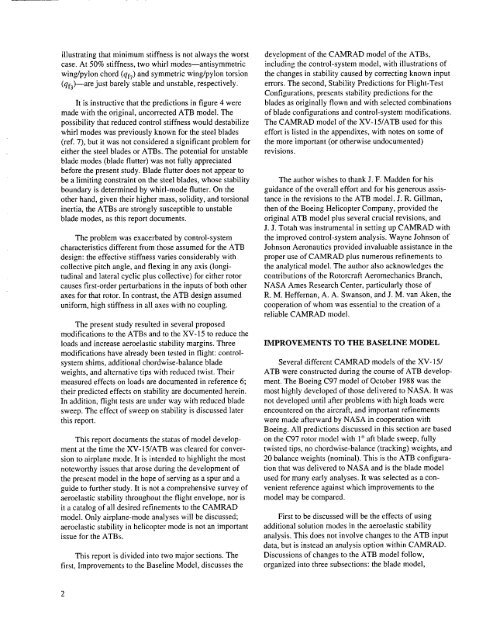Download - NASA
Download - NASA
Download - NASA
Create successful ePaper yourself
Turn your PDF publications into a flip-book with our unique Google optimized e-Paper software.
illustratingthatminimumstiffness isnotalwaystheworst development oftheCAMRADmodeloftheATBs,<br />
case.At 50%stiffness, twowhirlmodes--antisymmetricincludingthecontrol-system<br />
model,withillustrations of<br />
wing/pylonchord(qf7)andsymmetric wing/pylontorsion<br />
(qf3)--are justbarelystableandunstable, respectively.<br />
thechanges instabilitycausedbycorrecting knowninput<br />
errors.Thesecond, StabilityPredictions forFlight-Test<br />
Configurations, presents stabilitypredictions fo,"the<br />
It isinstructive thathepredictions in figure4were bladesasoriginallyflownandwithselected combinations<br />
madewiththeoriginal,uncorrected ATBmodel.The ofbladeconfigurations andcontrol-system modifications.<br />
possibilitythatreducedcontrol stiffnesswoul destabilize TheCAMRADmodeloftheXV-15/ATBusedforthis<br />
whirlmodeswaspreviously knownforthesteelblades effortislistedintheappendixes, withnotesonsomeof<br />
(ref.7),butit wasnotconsidered asignificant problemfor<br />
eitherthesteelbladesorATBs.Thepotential forunstable<br />
blademodes (bladeflutter)wasnotfullyappreciated<br />
themoreimportant (orotherwiseundocumented)<br />
revisions.<br />
beforethepresent study.Bladeflutterdoesnotappear to<br />
bealimitingconstraint onthesteelblades, whosestability TheauthorwishestothankJ.F.Madden forhis<br />
boundary isdetermined bywhirl-mode flutter.Onthe<br />
otherhand,giventheirhighermass, solidity,andtorsional<br />
guidanceoftheoveralleffortandforhisgenerous assistanceintherevisions<br />
totheATBmodel. J.R.Gillman,<br />
inertia, theATBsarestronglysusceptible tounstable thenoftheBoeingHelicopter Company, providedthe<br />
blademodes, asthisreportdocuments.<br />
originalATBmodelplusseveral crucial revisions, and<br />
J.J.Totahwasinstrumental insettingupCAMRADwith<br />
Theproblemwasexacerbated bycontrol-system<br />
characteristics different fromthoseassumed fortheATB<br />
theimprovedcontrol-system analysis. WayneJohnsonof<br />
JohnsonAeronautics provided invaluable assistance inthe<br />
design: theeffectivestiffnessvariesconsiderably with<br />
collectivepitchangle,andflexinginanyaxis(longitudinalandlateralcyclicpluscollective)<br />
foreitherotor<br />
causes first-order perturbations intheinputsofbothother<br />
axesforthatrotor.Incontrast, theATBdesignassumed<br />
properuseofCAMRADplusnumerous refinements to<br />
theanalytical model.Theauthoralsoacknowledges the<br />
contributions oftheRotorcraft Aeromechanics Branch,<br />
<strong>NASA</strong>AmesResearch Center, particularly thoseof<br />
R.M.Heffernan, A.A.Swanson, andJ.M.vanAken,the<br />
uniform,highstiffness inallaxeswithnocoupling. cooperation ofwhomwasessential tothecreationofa<br />
reliableCAMRADmodel.<br />
Thepresent studyresulted inseveral proposed<br />
modifications totheATBsandtotheXV-15toreducethe<br />
loadsandincrease aeroelastic stabilitymargins. Three<br />
modifications havealreadybeentestedinflight:control-<br />
I'MPROVEMENTS TO THE BASELINE MODEL<br />
systemshims,additional chordwise-balance blade<br />
Several different CAMRAD models of the XV-15/<br />
weights, andalternative tipswithreduced twist.Their<br />
measured effectsonloadsaredocumented in reference 6;<br />
ATB were constructed during<br />
ment. The Boeing C97 model<br />
the course<br />
of October<br />
of ATB develop-<br />
1988 was the<br />
theirpredictedeffectsonstabilityaredocumented herein. most highly developed of those delivered to <strong>NASA</strong>. It was<br />
Inaddition, flighttestsareunderwaywithreducedblade not developed until after problems with high loads were<br />
sweep. Theeffectofsweeponstabilityisdiscussed later encountered on the aircraft, and important refinements<br />
thisreport.<br />
were made afterward by <strong>NASA</strong> in cooperation with<br />
Thisreportdocuments thestatusofmodeldevelopmentatthetimetheXV-15/ATBwasclearedforconversiontoairplanemode.<br />
It isintended tohighlight themost<br />
noteworthy issuesthataroseduringthedevelopment of<br />
thepresent model inthehopeof servingasaspuranda<br />
guidetofurtherstudy. It isnotacomprehensive surveyof<br />
aeroelastic stabilitythroughout theflightenvelope, noris<br />
it acatalogofalldesiredrefinements totheCAMRAD<br />
model.Onlyairplane-mode analyses willbediscussed;<br />
aeroelastic stabilityinhelicopter modeisnotanimportant<br />
issuefortheATBs.<br />
Thisreportisdividedintotwomajorsections. The<br />
first,Improvements totheBaselineModel,discusses the<br />
Boeing. All predictions discussed in this section are based<br />
on the C97 rotor model with 1° aft blade sweep, fully<br />
twisted tips, no chordwise-balance (tracking) weights, and<br />
20 balance weights (nominal). This is the ATB configuration<br />
that was delivered to <strong>NASA</strong> and is the blade model<br />
used for many early analyses. It was selected as a con-<br />
venient reference against which improvements to the<br />
model may be compared.<br />
First to be discussed will be the effects of using<br />
additional solution modes in the aeroelastic stability<br />
analysis. This does not involve changes to the ATB input<br />
data, but is instead an analysis option within CAMRAD.<br />
Discussions of changes to the ATB model follow,<br />
organized into three subsections: the blade model,
















